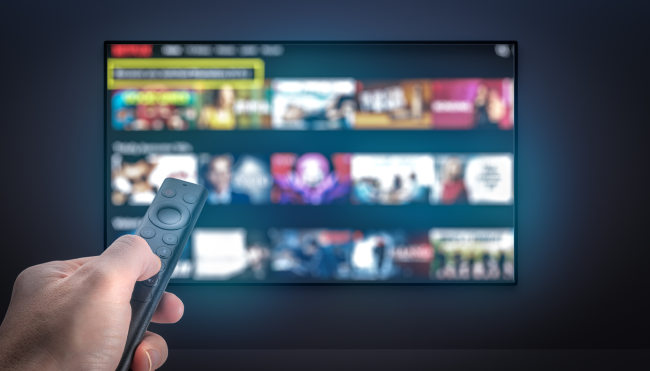- Why Amagi
-
Solutions
Contact UsBusinessWho We Serve
- Offerings
- AI
-
Resources
Contact UsINDUSTRY REPORTSAmagi FAST Report #15: The Power of Live Programming: A Catalyst for Streaming SuccessAugust 21, 2025Read More
-
Company
Contact UsNewsroomAmagi launches AI-powered Smart Scheduler to improve content programmingApril 3, 2025Read More
Blog
Your ultimate guide to Premium Video On Demand (PVOD)
By The Editorial Team, - June 23, 2023
With the increased adoption of Connected TV (CTV) across global households, audiences have a vast sea of viewing choices. Meanwhile, content owners continue to develop strategies to reach viewers more effectively and lucratively. This demand-supply equation has led to the emergence of various business models, namely SVOD (Subscription Video On Demand), AVOD (Advertising Video On Demand), TVOD (Transactional Video On Demand), and the latest – FAST (Free Ad-supported Streaming TV). Another streaming model that continues to evolve and deliver value is PVOD (Premium Video On Demand).
Let’s dive deeper.
What is PVOD?
As the name suggests, PVOD is a media distribution model where an Over The Top (OTT) provider offers viewers exclusive early access to video content, typically a movie, at a premium price.
This content could be:
- Released exclusively on OTT
- Streamed on OTT in parallel with a theatrical release on the same day
- Streamed after a short theatrical release window and unavailable for general SVOD viewers
PVOD is often confused with TVOD, which allows viewers to buy or rent already-released video content.
PVOD vs. VOD
In simple words, PVOD is a subset of VOD. VOD is a general term that refers to any form of content a viewer can access at their will. It has a few types – SVOD, TVOD, AVOD and PVOD. Let’s check out the differences between these in detail.
|
PVOD |
SVOD |
TVOD |
|
Allows you to watch new releases at a premium price |
You pay a recurring subscription fee to keep accessing content options |
You pay-per-view to watch individual titles |
|
You get to avail PVOD for a limited rental period |
No other charges involved except the subscription fee |
You can rent or purchase titles anytime |
|
Example: You rent a newly released title for $15 |
Example: Netflix, Disney+ Hotstar |
Example: Amazon Prime Video Rental services |
PVOD: Top advantages
1. Helps generate additional revenue
PVOD is a valuable tool for studios to generate additional revenue before making content available for SVOD. It offers a win-win situation to both streaming platforms and content owners. While content owners don’t need to fully rely on a film’s theatrical release, the streaming platform gets to attract more viewers.
With prominent studios increasingly featuring PVOD releases, it makes full sense for content owners to add PVOD to their distribution strategy. It helps drive new subscribers and increases the overall spending of existing ones. The other important aspect of the PVOD model is that the studios keep a significant portion of the revenue. Typically, the box office revenue is split between the studios and the cinema in a 50-50 share. With PVOD, the studios take up to 80% share, further adding to their revenues.
2. Keeps the viewers hooked
PVOD helps generate a buzz about the latest releases; it attracts subscribers to get exclusive access, especially during day-and-date releases (when a film becomes available in theaters and PVOD on the same day). With content owners getting stronger at the marketing game, generating the interest of SVOD audiences who would be willing to pay a premium price for good content also works well.
In certain cases, box-office sales even increased when films became available on PVOD, as it acted as an excellent marketing channel. The opposite is true for art-house films, where a theatrical release is a good marketing tool for PVOD rentals and purchases.
3. Helps reach a wider audience
Many movie enthusiasts may find it difficult to go to theaters to watch their favorite titles. This inability could result from not having a theater nearby or simply not wanting to step out. PVOD helps bring this set of audiences up to speed with the latest movies while getting good returns since these folks don’t mind paying extra for early access to their favorite content right from the comfort of their homes.
PVOD distribution and monetization
PVOD distribution typically follows a direct-to-consumer (DTC) model, where studios partner with digital platforms like Amazon Prime Video and Apple TV or proprietary studio platforms like Disney+ Premier Access.
Some common monetization strategies include:
- Transactional sales: Charging consumers per view or rental.
- Bundling: A special bundle with bonuses grants exclusivity to the PVOD content.
- Limited-time access: Availability is limited to a specific time frame to create urgency.
- Hybrid releases: Maximize reach and revenue through simultaneous theatrical and PVOD releases.
Some common PVOD examples include:
- "Mulan" (Disney+ Premier Access) – Released in 2020, Disney offered the movie for $29.99 before it became available for regular subscribers.
- "Trolls World Tour" (Universal Pictures) – One of the earliest successful PVOD releases, grossing over $100 million in digital rentals.
- "Wonder Woman 1984" (Warner Bros.) – Released simultaneously in theaters and on PVOD, offering flexibility to audiences during the pandemic.
Does PVOD have a bright future ahead?
While the big screens are here to stay, PVOD isn’t going anywhere either. Content being king, a movie buff will seek out good movies from any available medium. Data plays a crucial role in making PVOD gain the traction it deserves: with studios holding customer and viewership data, getting insights into what works and what doesn’t helps generate more targeted content. We’ve all seen a movie that didn’t perform particularly well in theaters but did exceptionally well on VOD. Such films are a gold mine for PVODs.
The key to understanding the PVOD formula is to gain in-depth viewership insights, and powerful tools like Amagi ANALYTICS can provide such detailed data.
An additional VOD superpower we tend to ignore is direct access to consumers. Film marketing costs account for 40% of a film’s budget, so direct access to audiences through on-demand platforms provides the right marketing channel to support a film.
With the power of data and quick access to viewers, PVOD will continue to be a promising source of revenue for both content owners and platforms.
Want to learn more?
- Watch our full webinar series here
- Talk to us to learn more
- Read our latest Global FAST Report
Related Blogs
Get started
Increase revenue and reach with our Broadcast & Streaming solutions.
Cloud modernization. Streaming unification. Monetization. Marketplace.
 German
German French
French Spanish
Spanish Korean
Korean Japanese
Japanese Portuguese
Portuguese


